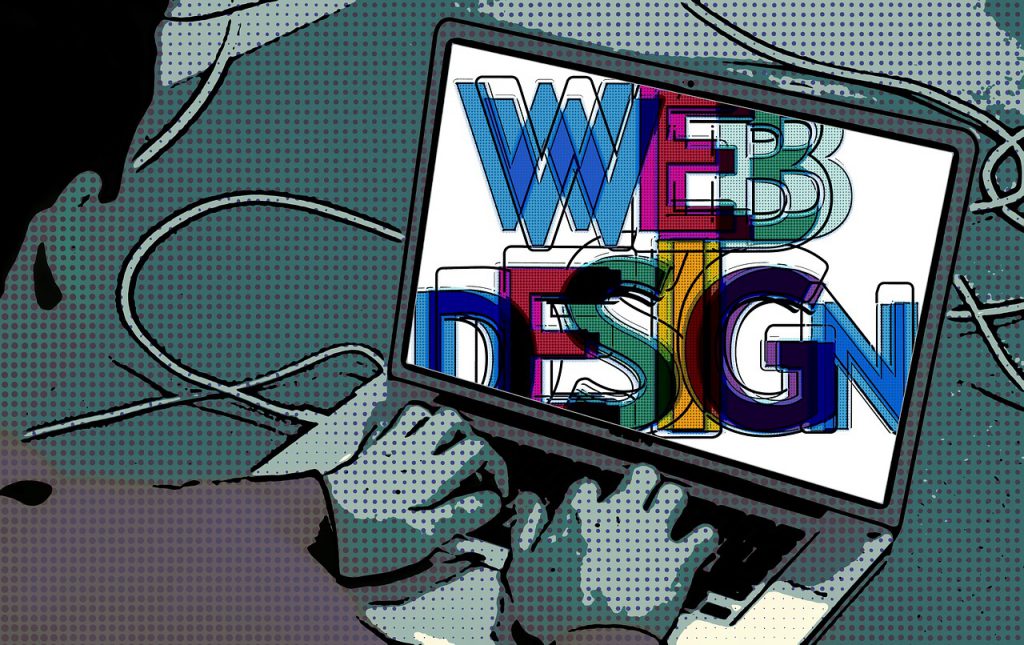The Mind’s Eye: Decoding the Psychology of Web Design
The digital landscape is not just about code and aesthetics; it’s a psychological playground where every pixel can influence perception and behavior. The “Psychology of Web Design” delves deep into the cognitive processes that govern our interactions with websites. It’s where art meets science, creating a harmonious blend that can lead to increased engagement and conversion rates.
The Psychological Palette: Colors, Typography, and Layout
Color Connotations
Red: Urgency and Energy Red is a powerful color that can evoke strong emotions. It is often associated with urgency, making it a popular choice for call-to-action buttons and sale announcements. Red can also convey energy and excitement, which can be leveraged in designs to draw attention and stimulate quick decision-making.
Blue: Trust and Serenity Blue is a color that’s commonly linked to trustworthiness and reliability. It’s no coincidence that many financial institutions and healthcare companies use blue in their branding. Additionally, blue has a calming effect, invoking a sense of serenity and peace. This makes it an excellent choice for designs that aim to promote calm and focus.
Green: Growth and Calm Green is a versatile color that often represents growth, reflecting nature’s own greenery and abundance. It can also be calming, reminiscent of vast, serene landscapes. In design, green can be used to symbolize sustainability and eco-friendliness or to create a sense of balance and renewal.
Typography and Cognitive Flow
Serif vs. Sans-serif The choice between serif and sans-serif fonts can significantly affect the cognitive flow of a design. Serif fonts are often seen as traditional and formal, suggesting credibility and authority. They are commonly used in print media such as newspapers and books. Sans-serif fonts, with their clean and modern lines, are perceived as more casual and approachable. They’re often used in digital platforms for readability and simplicity.
Readability vs. Personality Typography is not just about making words legible; it’s also a powerful tool to inject personality into content. While readability ensures that text is easy on the eyes and information is easily processed, the personality of a typeface can evoke emotions and set the tone of the communication. A balance between the two is vital for effective design.
Layout and Spatial Psychology
The ‘F’ Pattern: How Eyes Navigate Research on eye-tracking has revealed that people typically scan screens in an ‘F’ pattern, reading across the top, down the side, and then across again. Understanding this pattern can inform the layout of web pages, ensuring that important information catches the reader’s attention.
White Space: Breathing Room for Thoughts White space, or negative space, is the empty area around design elements. It’s not merely blank space but a critical component of design. It gives the viewer’s eyes a rest, reduces cognitive overload, and helps prioritize content by drawing attention to specific elements. Effective use of white space can significantly improve user experience by making information digestible and accessible.

Emotional Contours: Imagery and Storytelling
The Human Touch: Images That Connect
Authenticity in Stock Photography
Genuine representations in stock photography can make a profound connection with the audience. Authentic images resonate more deeply than obviously staged ones because they reflect real-life scenarios that viewers can relate to. This authenticity can help to foster a sense of trust and relatability between the brand and its audience.
Emotional Triggers Through Visuals
Visuals can be a powerful tool for evoking emotions in your audience. By understanding the psychology of color, composition, and imagery, you can create images that tap into viewers’ emotions, reinforcing the message you want to convey. Whether it’s joy, trust, or curiosity, the right visuals can create a lasting impression and forge a deeper connection with your content.
Narrative Power: Building a Story
User Journey as a Story Arc
The user journey can be conceptualized as a narrative with a beginning, middle, and end. Each interaction is part of a larger story that leads the user through a seamless flow, from initial engagement to the final goal. Crafting this journey with the care of a storyteller can enhance the user experience, making it not just functional but memorable.
Micro-interactions: Small Stories, Big Impact
Micro-interactions are the minute, yet crucial, interactions that occur between users and the interface. They might be as simple as the feedback from a button press or the animation of a loading icon. These small stories enrich the overall narrative, providing delight and a sense of accomplishment, and they can significantly amplify the user’s emotional connection to the product.
Interactive Psychology: UX/UI and Responsiveness

Click with Purpose: The Call-to-Action (CTA)
Color, Size, and Placement: What Works?
The effectiveness of a CTA is often determined by its color, size, and placement. Colors that contrast with the site’s color scheme can make the CTA stand out, while the size should be large enough to be noticeable without overwhelming the rest of the design. Placement is critical; a CTA should be positioned in a location where users naturally focus, such as the center of the screen or at the end of content, to encourage interaction.
Words that Prompt Action
The language used in a CTA can greatly influence click-through rates. Action-oriented, compelling, and urgent words encourage users to take the desired action. Phrases like “Get started,” “Learn more,” or “Don’t miss out” can create a sense of immediacy and relevance, prompting users to click. The choice of words should align with the overall brand voice and the specific action you want users to take.
Navigational Instincts: Menu Design and Flow
Intuitive vs. Innovative Navigation
The debate between intuitive and innovative navigation revolves around user familiarity versus unique experiences. Intuitive navigation follows established conventions that users are already comfortable with, reducing the learning curve and potentially increasing usability. Innovative navigation designs can differentiate a brand and create memorable experiences but may require users to learn new patterns, which can hinder immediate usability.
Mobile-first: The Thumb-Friendly Zone
With mobile usage surpassing desktop, designing for a mobile-first experience is essential. This includes creating thumb-friendly navigation, where all interactive elements are easily reachable with one hand and can be navigated using a thumb. This approach prioritizes the comfort and ergonomics of mobile users, ensuring that the navigation feels natural and effortless on smaller screens.
The Trust Factor: Credibility and Persuasion
Building Credibility Through Design
Consistency and Cohesion
Consistency in design elements such as color schemes, typography, and layout across all pages of a website or application reinforces brand identity and contributes to a sense of reliability and professionalism. Cohesion ensures that the product feels like a unified whole, rather than a disjointed collection of parts, which can significantly boost the user’s trust in the brand.
Testimonials and Trust Symbols
Incorporating testimonials from satisfied customers or clients can provide social proof, lending credibility to your products or services. Trust symbols, like security badges, endorsements from well-known figures, or logos of partner companies, also serve as powerful indicators of credibility and can reassure users that they are making a safe and sound decision by engaging with your brand.
Persuasive Design: The Art of Conversion
Scarcity and Social Proof
Scarcity, implying limited availability, can create a sense of urgency that encourages users to act quickly to avoid missing out. Social proof, such as user reviews and ratings, showcases the popularity and acceptance of a product or service, influencing potential customers by showing that others have made the same choice and are satisfied with it.
Reciprocity and Commitment
The principle of reciprocity suggests that people feel obliged to give back when they receive something. In design, this can be leveraged by offering free trials, informative content, or user-friendly tools, which may incline users to return the favor in the form of a purchase or subscription. Commitment can be fostered by designing experiences that encourage users to take small steps, such as signing up for a newsletter, which can lead to more significant actions in the future.
FAQs: Minds Want to Know
How does color psychology affect website conversion rates?
Color psychology can have a significant impact on website conversion rates. Different colors can evoke different emotions in users, which can affect their behavior on a site. For example, red can create a sense of urgency, which might increase the likelihood of a purchase during a sale. Blue can instill a sense of trust and security, potentially increasing sign-ups or conversions on financial or health-related websites. The strategic use of color in call-to-action buttons, banners, and other key conversion areas can draw attention and motivate users to take the desired action. It’s important to consider the target audience, cultural connotations of colors, and the overall design aesthetic to effectively use color psychology to improve conversion rates.
Can typography improve website readability and retention?
Yes, typography can significantly improve website readability and retention. The choice of font type, size, spacing, and color affects how easily users can read and absorb information. Clear, legible typography helps reduce eye strain and cognitive load, leading to a better user experience. Fonts with personality can align with brand identity and enhance the message, increasing the memorability of the content. When users can read content easily and feel an emotional connection to the way it’s presented, they’re more likely to stay longer on the site and retain the information they’ve read.
What layout patterns contribute to user engagement?
Certain layout patterns are particularly effective in contributing to user engagement. The ‘F’ pattern, for instance, aligns with the natural reading behavior of users in the West, who scan pages horizontally from left to right, starting from the top. Ensuring that important information is placed along these lines can increase the chances of user engagement. Grid layouts provide a structured and clean approach to organize content, making it easier for users to navigate and find information. The use of white space is also crucial; it can help focus user attention on important elements, reduce cognitive overload, and make the user experience more pleasant. Interactive elements and responsive designs that adjust to different screen sizes also enhance engagement by improving accessibility and usability across devices.
The Art and Science of Web Design
In the realm of web design, understanding the psychological impact of your design choices can transform user experience from mundane to memorable. It’s about creating a digital environment that feels intuitive, engages emotions, and guides visitors towards desired actions. The psychology of web design is the unseen current that can carry your website towards success.
In This Article
- The Mind’s Eye: Decoding the Psychology of Web Design
- The Psychological Palette: Colors, Typography, and Layout
- Emotional Contours: Imagery and Storytelling
- Interactive Psychology: UX/UI and Responsiveness
- Click with Purpose: The Call-to-Action (CTA)
- The Trust Factor: Credibility and Persuasion
- FAQs: Minds Want to Know
- The Art and Science of Web Design